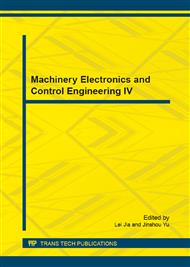[1]
Zhou Bihua, Chen Bin, Shi Lihua. Electromagnetic Pulse and Engineering Protection, in Chinese. Beijing: National Defence Industrial Press, (2003).
Google Scholar
[2]
Orzan, D. Time-Domain Low Frequency Approximation for The Off-Diagonal Terms of The Ground Impedance Matrix,. IEEE Transactions on Electromagnetic Compatibility, Vol. 39, Feb. (1997).
DOI: 10.1109/15.554697
Google Scholar
[3]
Visacro, S. and Rosado, G. Response of Grounding Electrodes to Impulsive Currents: An Experimental Evaluation,. IEEE Transactions on Electromagnetic Compatibility, Vol. 51, Feb. 2009: 161-164.
DOI: 10.1109/temc.2008.2008396
Google Scholar
[4]
Nor, N.M., Trlep, M. et al. Determination of Threshold Electric Field of Practical Earthing Systems by FEM and Experimental Work,. IEEE Transactions on Power Delivery, Vol. 28, Oct. 2013: 2180-2184.
DOI: 10.1109/tpwrd.2012.2227511
Google Scholar
[5]
Loyka, S.L. On Calculation of The Ground Transient Resistance of Overhead Lines,. IEEE Transactions on Electromagnetic Compatibility, Vol. 41, Aug. 1999: 193-195.
DOI: 10.1109/15.784153
Google Scholar
[6]
Bo Zhang, Jinliang He, Rong Zeng, et al. Effect of Grounding System on Electromagnetic Fields around Building Struck by Lightning,. IEEE Transactions on Magnetics, Vol. 46, No. 8, Aug. 2010: 2955~2958.
DOI: 10.1109/tmag.2010.2048307
Google Scholar
[7]
Fan Shaosheng, and Wang Bing. Application of Fuzzy Modeling to Identify the Soil Resistivity of Dynamic Grounding System,. 2008 International Conference on Intelligent Computation Technology and Automation, p.855~858.
DOI: 10.1109/icicta.2008.276
Google Scholar
[8]
A.A. Al-Arainy, N.H. Malik, M.I. Qureshi and Y. Khan. Grounding Pit Optimization Using Low Resistivity Materials for Applications in High Resistivity Soils,. International Journal of Emerging Electric Power System. Vol. 12, Issue 1, Article 3, (2011).
DOI: 10.2202/1553-779x.2591
Google Scholar
[9]
A.A. Al-Arainy, Y. Khan, and N.H. Malik, et al. Grounding Pit Optimization for Uses in High Resistivity Areas, Proc. GCC-CIGRE 2010, Oct. 2010, Qatar.
Google Scholar
[10]
Run Xiong. Bin Chen. et al. FDTD Modeling of The Earthing Conductor in The Transient Grounding Resistance Analysis,. Antennas and Wireless Propagation Letters, IEEE. Vol. 11, Aug. 2012: 957-960.
DOI: 10.1109/lawp.2012.2213569
Google Scholar


